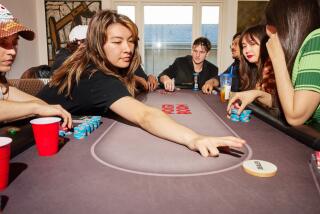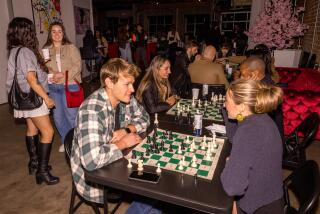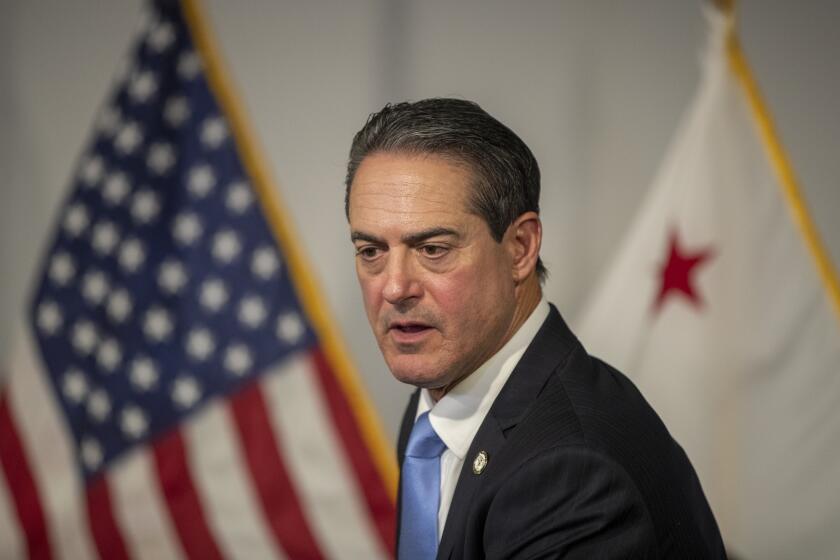For Alzheimer’s and dementia patients, pingpong is a game — and therapy
- Share via
On TV screens around the room, Chinese table tennis players are whirling and vaulting, but Betty Stein isn’t watching them.
She’s utterly absorbed in the ball coming right at her, and she nails it — 10, 20, 30 times, shooting it back at her enthusiastic Ukraine-born coach, Bella Livshin.
“Gorgeous!” Livshin cries. “A beauty! Backhand, forehand, forehand, backhand — faster! Look how smooth, how flowing — she’s a natural!”
Stein doesn’t say much these days. Nobody knows whether it’s the Alzheimer’s, the medication, maybe a touch of depression. Whatever it is, the perfectly coiffed, stylishly dressed 92-year-old Stein keeps her silence. But after 40 minutes at the table, she doesn’t slow down.
“You tired yet?” Livshin asks.
Stein shrugs. She misses a high, arcing shot, takes another unsuccessful swat and connects on the third try. The ball hasn’t had time to bounce more than once.
A concentration camp survivor whose portrait hangs in the Los Angeles Museum of the Holocaust , Stein carries herself with elegance, even at the pingpong table. At times she holds her left hand aloft, in the manner of a duchess calling for biscuits at afternoon tea. Still, she counters Livshin’s strokes one after another, steady as the pendulum on a grandfather clock.
She was once more outgoing. She had lots of friends and was active in Jewish organizations.
“She used to tell me her dreams of this and that,” said Flor Narvaez, the caregiver who brings Stein to the Arthur Gilbert Table Tennis Center in the Mid-Wilshire area, which began offering pingpong lessons for people with Alzheimer’s and dementia about a year ago. Stein resisted at first: She walks with a cane. She worried about falling down. She didn’t know anything about pingpong.
From his tiny office looking over a roomful of tables, Mikhail Zaretsky, the center’s director, leans out and yells: “Betty, you are the best!”
She allows herself a tiny smile, blows him a quick kiss — and keeps on playing.
::
Zaretsky, 49, is a huge pingpong partisan. In 2003, he founded the Gilbert center, one of the few spots in Los Angeles where serious players train.
His Alzheimer’s program, which he runs both at the center and at various senior facilities, has drawn about 100 participants. At up to $25 a half-hour — players are charged on a sliding scale — the sessions aren’t necessarily cheap. But the ones who stick with it experience big changes in alertness, balance and coordination, Zaretsky said. And they find unexpected little joys their disease hasn’t yet extinguished.
“They have to predict where the ball is going, they have to respond to distance, they have to respond to time,” Zaretsky said. “They have to be there!”
In his native Belarus, Zaretsky was a youth champion, and then a coach. But when glasnost opened the door for Jews who wanted out, he left in 1988 — and came to a land where pingpong, his life’s passion, was mostly relegated to suburban basements.
He mopped up at a deli. He sold cars. He did a lot to get by but little that he loved. Then in a dazzling Hollywood moment, the immigrant crossed paths with a multimillionaire.
Arthur Gilbert, then 80, couldn’t play tennis any longer but was relentlessly competitive. Feeling a need to crush his lawyer at table tennis, he called a training center looking for a coach.
“Russian or Chinese?” they asked him.
Suddenly, Zaretsky, who was working nights at a facility for the mentally disabled, was giving three or four lessons a week on the covered patio at Gilbert’s Beverly Hills estate. He was also a frequent guest at dinner parties, where he hobnobbed with Gilbert’s pals from politics and Hollywood.
“He always wanted me there — sometimes not to play but just as a social event,” Zaretsky said. “You know: ‘I’d like you to meet the Belarussian national table tennis champion.’ ”
At Gilbert’s request, Zaretsky organized an international table tennis competition in Los Angeles. From 1996 to 1998, players vied for the Gilbert Cup — but its namesake’s declining health and the demands of his world-class art collection put an end to it.
Gilbert had made a fortune in evening gowns, and then another in real estate. In 1996, he yanked his $200-million collection of gold snuffboxes and other decorative objects from the Los Angeles County Museum of Art, which he said had not displayed them adequately, and gave them to the United Kingdom.
In exchange, a museum display in his native London included a wax likeness of Gilbert at home in his tennis togs. A grateful Queen Elizabeth knighted him in 1999.
Sir Arthur Gilbert died two year later. With money awarded to him by Gilbert’s foundation, Zaretsky opened the Arthur Gilbert Table Tennis Center in 2003. Based in the Westside Jewish Community Center, it has seven tables, two ball-serving robots and a number of older patrons who are proud to keep their eyes on the ball.
::
“Hey, here’s my girl!” Eli Boyer cries. “She’s pretty, right? I love pretty girls and this is a pretty girl!”
Boyer is excited. At 91, the retired CPA walks with a shuffle. He suffers from dementia and sometimes chants endless strings of nonsense syllables. But when it comes to his coach, Elie Zainabudinova — tall, fit and a former member of Kazakhstan’s national table tennis team — he’s crystal-clear.
“How about a kiss, beautiful?” he says.
Laughing, Zainabudinova engages him in a spirited volley, trying to keep the ball going as long as possible. No scores are kept: The play’s the thing.
Looking on, Michele Boyer, Eli’s wife of 50 years, is thankful.
“Maybe he’s using more of his brain when he plays pingpong,” says the sculptor and former dancer. “Afterward, he has more energy, he talks more, he walks twice as fast — it’s amazing to me.”
Whether pingpong has a therapeutic effect on people with Alzheimer’s and dementia is an open question.
A 1997 Japanese study suggested it might. (Like some 300 million other table tennis advocates in countries throughout the world, the Japanese take the sport seriously enough to study it.) But the Alzheimer’s Assn., while declining to address pingpong specifically, says researchers have found no silver bullet in their fight against the disease.
“The strongest evidence that we have right now for possible risk reduction in Alzheimer’s and dementia points to the benefits of regular physical activity,” said neuroscientist Maria Carrillo, the association’s director of medical and scientific relations. “What we don’t have yet is a specific prescription for which activities are best at reducing Alzheimer’s risk, or how long or how hard you need to do them.”
Daniel Plotkin, a geriatric psychiatrist in Los Angeles, is also cautious but hopeful.
“Mainstream medicine doesn’t have a lot to offer these patients,” he said. “But meanwhile we need to give them opportunities to be engaged in life, to feel some sort of meaning and purpose.”
The founder and former director of UCLA’s Alzheimer’s clinic, Plotkin has directed patients into horseback riding, piano lessons, art classes — and pingpong.
“I don’t think it’s necessarily changing the brain or slowing down the disease or doing anything unique that other interventions don’t do,” he said. “But I think it’s fabulous.”
Plotkin is on the board of advisors of the Sport and Art Educational Foundation, a nonprofit Zaretsky created in 2007. The group, which Zaretsky said he formed to “give back” to his adopted country, first focused on helping disabled children, then on Alzheimer’s patients. He’s used his own money, but donations from pingpong equipment companies and other businesses have helped.
Plotkin has steered a number of his clients, including physicians, to the program.
One former surgeon, upset about his lost dexterity, was skeptical at first but came to enjoy it.
“He feels a difference,” Plotkin said. “He likes how he’s stroking the ball. He’s a little more confident the rest of the day. He gets a kick out of his instructor. It may well be helpful, in terms of engagement and structure, in some mysterious way we don’t understand.”
If there’s a mystery, Eli Boyer isn’t puzzling over it.
Using a grip perfected by the Chinese but not often seen in the U.S., he rallies long and hard with Zainabudinova. When his kids were growing up he had a pingpong table in the basement. It’s not something, his wife says, that he remembers now.
To break up his stream of vaguely melodic nonsense syllables, Zainabudinova asks him to sing “Besame Mucho” — which he does, in excellent Spanish, while returning her shots. Sometimes they sing Beatles songs together.
There was a time when Boyer was the life of the party, the guy who could sit down at someone’s piano and suddenly have everyone in the room singing. He still jokes incessantly — in three languages — and has been known to serenade Zainabudinova with lullabies in Russian.
“Some things he may not remember,” she says, “but he has not forgotten how to flirt.”
More to Read
Sign up for Essential California
The most important California stories and recommendations in your inbox every morning.
You may occasionally receive promotional content from the Los Angeles Times.














